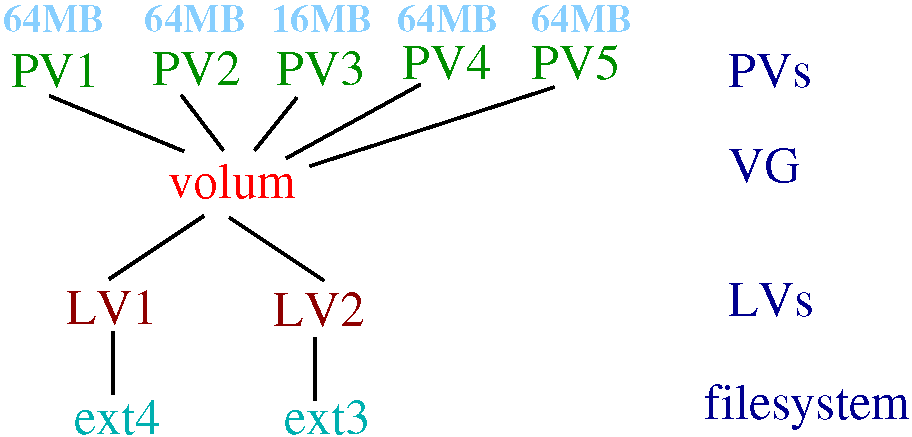ANATOMY OF LVM

-
VG (Volume Group): gathers together LVs and PVs into one administrative unit.
-
PV (Physical Volume): a PV is typically a hard disk (partition), raid device, etc...
-
LV (Logical Volume): the equivalent of a disk partition in a non-LVM system.
-
PE (Physical Extent): each PV is divided in chunks of data, known as PEs. These extents have the same size as the LEs.
-
LE (Logical Extent): each LV is split into chunks of data, known as LEs.
Mapping modes (linear/striped)

-
We now can create a LV (LV1).
-
LV1 can be any size between 1 and 347 (99+248) extents.
-
When LV1 is created, a mapping is defined between LEs and PEs (eg. LE[i] could map onto PE[i] of PV1 and PE[i] of PV2).
-
Strategies for mapping LEs onto PEs:
-
Linear (similar to RAID Linear) mapping will assign a range of PEs to an area of an LV in order (eg., LE[1 - 99] map onto PV1 and LE[100 - 248] map onto PV2).
-
Striped (similat to RAID0):
LE[1] --> PV1[1]
LE[2] --> PV2[1]
LE[3] --> PV1[2]
and so on.
-
Snapshots
-
Snapshots allows the administrator to create a new block device which is an exact copy of a LV, frozen at some point in time.
-
Used when for instance, we need to perform a backup on the LV, but you don't want to halt a live system that is changing the data.
Boot time script
- The startup of LVM requires just the following two commands:
# vgscan
vgscan – reading all physical volumes (this may take a while...)
vgscan – "/etc/lvmtab" and "/etc/lvmtab.d" successfully created
vgscan – WARNING: This program does not do a VGDA backup of your volume group
# vgchange -ay
- And the shutdown only one:
# vgchange -an
Startup script (/etc/init.d/lvm)
#!/bin/sh
case "$1" in
start) /sbin/vgscan
/sbin/vgchange -ay ;;
stop) /sbin/vgchange -an ;;
restart|force-reload)
/sbin/vgchange -an && /sbin/vgscan && /sbin/vgchange -ay ;;
esac
exit 0
LVM Files
-
/etc/lvmtabInforms about the activated VGs
-
/proc/lvm/*Inform about the VGs structure
-
/dev/my_VG[1-n]/*LVM device files